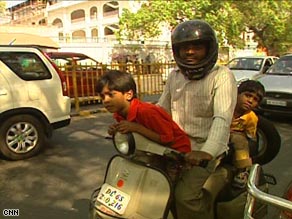Indians line up to drive away Nano car
- Story Highlights
- Tata Motors to begin delivery of the Nano in July
- Industry experts say motor is surprisingly good, environmentalists disagree
- Car is billed as the world's cheapest, costing $2,000
- Next Article in World Business »
CNN
NEW DELHI (CNN) -- Suraj Suroj uses his motorcycle for all of his family's transportation needs. In his case, that means transporting himself, his wife and his two sons to and from work and school. Typically, all four of them squeeze onto the motorbike together on the crowded streets of Delhi, India.

Suraj Suroj and his two sons weave through the streets of Delhi on his motorcycle.
"We need more space," Suroj says with one of his sons sitting in front of him and the other clinging to his back. "We can only travel about 20 kilometers or 25 kilometers, after that we get tired traveling on the scooter."
Never mind the fact that it's a very dangerous way to travel. The traffic is chaotic, constant, and congested and neither of Suroj's sons have helmets. Millions of people travel this way in India because helmet laws are not enforced and a two wheeler is the best they can afford.
Not any more.
Monday, Tata Motors finally released what has become known as the "world's cheapest car." With the basic model going for about $2,000, the Tata Nano is being touted as an alternative to motorbikes and scooters.
In dramatic fashion, three versions of the Nano were driven onto a dark stage with headlights flashing and invited guests clapping in Mumbai, India. Tata Motors says the Nano will be available for purchase on April 9 but won't be delivered to customers until July. ![]() Watch as Nano is unveiled »
Watch as Nano is unveiled »
The vehicle has received international attention since it was first revealed in January 2008 at an Auto Expo in Delhi. Tata promised it at an incredibly low price. As the economy began to falter last year and the cost of materials started to rise, analysts began to doubt whether Tata could pull it off.
Chairman of Tata group, Ratan Tata, answered those critics at the launch. "We made a promise and we've kept the promise. We hope this day we will usher in a new form of transport," Tata said.
But the launch of the Nano is months behind schedule. The company ran into trouble when a land dispute sparked angry protests over the building of the Nano plant in the communist stronghold state of West Bengal. Farmers said the land belonged to them.
In the end, Ratan Tata decided to stop operations and move to another state which caused a delay and cost Tata Motors millions.
But the Nano has finally arrived.
Industry experts say the base model is really basic but looks modern, is surprisingly spacious and handles well.
"I think it will live up to what has been promised but it will not live up to what some people may imagine," auto analyst Murad Baig said. "If some people may imagine that this is going to be a golden chariot, no it won't. But it will be an economical, safe, practical, economical to buy, economical to run and a very cute little car, I must say."
Don't Miss
At only three meters long, the Nano fits four adults relatively comfortably. Critics point out that the cheapest version of the vehicle comes without air conditioning, airbags or power windows and it only has one side-view mirror. The Nano's speeds top out at 105 kilometers (65 miles) per hour.
Tata says the Nano, which meets Indian environmental standards, has the lowest emissions among cars in its class. But environmentalists are not cheering its arrival. They are worried the Nano will simply add to the number of vehicles already choking the roads.
"We are not saying no to Nano. We are saying no to all cars," said Amanita Roychowdry, a representative of India's Center for Science and Environment.
"What is happening right now is that already when car numbers are exploding in Indian cities what cheap motorization is going to do is going to give that extra push. And that is what worries us. Anything that increases the number of cars on our roads is a bad news."

No one knows, however, if the Nano will increase numbers or simply replace other cars in its class. For now, the Nano sounds like a fantastic alternative for those families in India who are trying to navigate crowded streets while crammed together on a motorcycle.
"We will definitely be able travel farther with a Nano," motorcycle driver Suraj Suroj said. "Why not? We will be able travel comfortably. There will also be more safety."

 Sit tight, we're getting to the good stuff
Sit tight, we're getting to the good stuff
